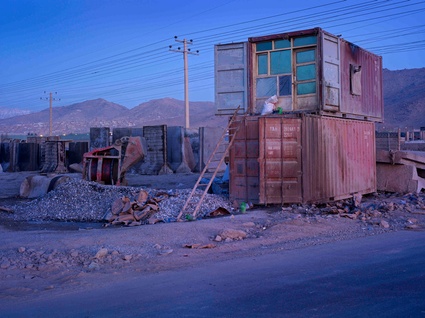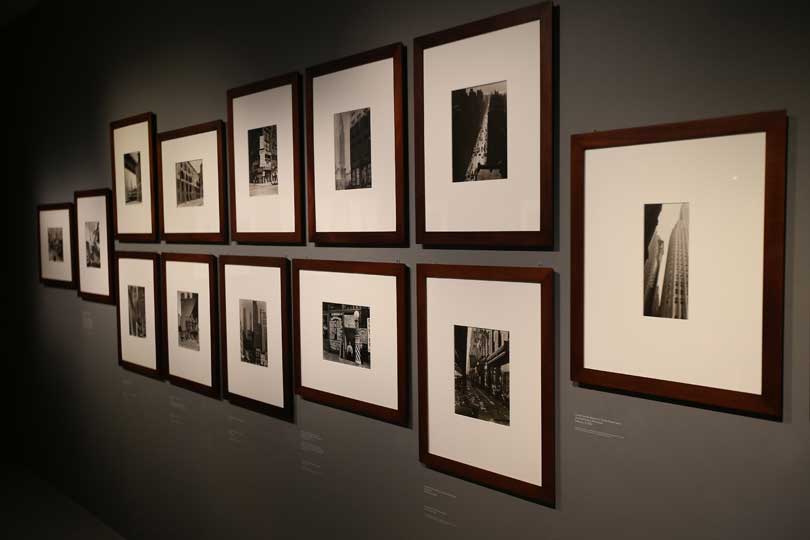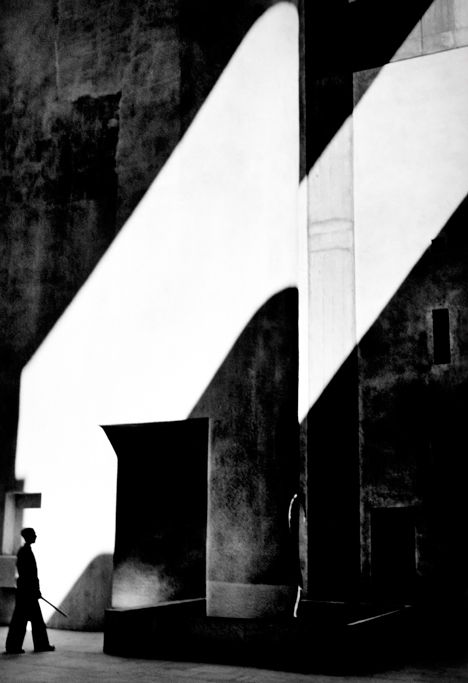 |
| Simon Norfolk, A Home Made of Shipping Containers, Kabul |
I had many questions of this vast
exhibition of photography. Is it really about the intersection of photography
and architecture, or is architecture the thread that loosely holds together a
certain history of art photography in the twentieth century? The photographers
collected here are among the most celebrated of the last 100 years, and it’s
really exciting, if overwhelming, to see all their work together. Strictly
speaking, however, a number of the photographs in the exhibition were not about
architecture. Works by Berenice Abbot, Walker Evans, and later on, Simon
Norfolk and Nadav Kander, among others, are exemplary of the development of
photography and its negotiation as representation of space over the past 100
years, but they are not representations of architecture. Space, light, surface,
and their intersection with photographic representation are the more likely foci
of Constructing Worlds.
 |
| Berenice Abbott's photographs in Constructing Worlds |
My second question for the curators is the
size of the exhibition. As I say, there is no doubt that it is a treat to see
all these great photographs in one space, but to be honest, I found it too
much. It is impossible to get an overall sense of over 250 photographs by 18
photographers, that span the 20th and 21st centuries, as
well as every continent on earth. With this challenge in mind, here are my
thoughts.
What stood out for me was my introduction
to some photographers I wasn’t previously familiar with and to those by others
whose other work I know well. Hiroshi Sugimoto’s blurred and confused spaces
and places of erasure are breathtaking. And they become haunting, unforgettable
when we learn that they are actually representations of the World Trade Towers
in 1997, four years before they were destroyed, it is as though Sugimoto knew
the fate of the twin towers. Sugimoto’s long exposure technique has produced a
very different, but nevertheless, powerful result in these huge black and white
images.
 |
| Lucien Hervé, High Court of Justice in Chandigarh, 1955 |
Upstairs, Lucien Hervé’s photographs of the
High Court of Justice in Chandigarh, India 1955 stood out for their abstraction
among works that were, for the most part, interested in some form of
documentary realism. Hervé’s almost delicate images are both an ode to the
medium of photography as no more and no less than images of light. Hervé more
than anyone else in the 1950s represented in the exhibition is pushes the image
in its relationship with architecture into abstraction through silver gelatin
prints. And simultaneously, as he photographs Le Corbusier’s radical building,
he finds an architecture as well as a mode of representing it that breaks new
ground in the 20th century.
 |
| Guy Tillim, Apartment Building Avenue Kwame Nkrumah Maputo Mozambique, 2008 |
By the time I reached Guy Tillim’s
photographs downstairs, I was convinced that photography is the superior medium;
its flexibility, vast possibility and ability represent, reconstruct and
document all at the same time. And yet, I was frustrated again because Tillim’s
familiar sensuous, but rough and organic surfaces are almost de-politicized when
we don’t get any information regarding the production and more importantly, his
printing process. Tillim’s technique is everything. To be sure, of course, the
images are about the dilapidated, derelict government buildings and luxury
hotels, the state of decay of his native post-colonial Africa. But the blunt,
hard vision of Africa is brought to life through his use of pigment ink on
cotton rag paper to give the buildings a wet texture that is key to their
political edge. Along the same lines, nothing is mentioned of Gursky’s digital manipulation
of the image in production and post-production to stretch the underground
subway station of Sao Paolo, Sé
(2002) in his characteristic rendering of an everyday space of capitalism, an
isolated superficial structure.
 |
| Nadav Kander, Chongqing IV (Sunday Picnic), Chongqing Municipality 2006 |
Nadav Kander’s photographs of the Yangtze River
and the industrial developments that have taken place there are mesmerizing. Their
empty, effaced backgrounds, the traces of structures that could be from the
past or the future, it’s difficult to say which, are at first glance, almost
Romantic. And then up close, the enormity of the structures, their overwhelm of
the people takes over, becoming ever more noticeable. In what is unusual for
the photographs in this exhibition, people existed in the reconstructed worlds
of China, but they are always dwarfed by the development of industry along the
Yangtze. And for us, who are so aware of the imperative to take care of our
landscape, Kander’s photographs show the violation of a landscape that otherwise
has no hope. Thus, after time, the transformation of the river is like a
descent into hell shown in Kander’s images.
I also enjoyed seeing Simon Norfolk’s Afghanistan images. His excessive use of
filters simultaneously creating a superficial vision of bullet scarred, war
torn Afghanistan, as well as exposing how the same spaces are repurposed to
functional everyday uses. There is no mercy in this world – sun and light may
shine brightly on seductive landscapes, but they are populated by buildings and
worlds that have been destroyed. The irony is everywhere in Norfolk’s images.
 |
| Luisa Lambri, Darwin D. Martin House (1905) designed by Frank Lloyd Wright, 2007 |
Luisa Lambri’s negative spaces were
compelling and lyrical, as she finds what cannot be documented, what is left unspoken
for in the built environment. Her prints explore corridors, doorways,
thresholds, the caverns and crevices that might otherwise be ignored. Lambri’s are in the same vein as Hélène Binet’s
captivating images of the Libeskind Jewish Museum in Berlin. But where the
latter creates dimensionality and volume through filling space with light,
Lambri does the opposite, closing down the spatial environment so that only
what is otherwise invisible is traced in light. I was interested to see that
these two examples of work that no longer expose the structures and surfaces of
the architectural, are by women. It’s women who are interested in space, in the
unsaid, the invisible.
| Hélène Binet, Jewish Museum, Berlin, 1998 |
And in this, their work strongly resonated
with that of Berenice Abbott upstairs. In the 1930s, the student of Man Ray was
interested in finding the spaces that are completely taken up by buildings,
closing out sky. Abbott’s photographs were about the density and intensity of
New York, the city it would become, sculpted through the intensity of the
relationship between light and the camera, the chiaroscuro able to be created
through the specificity of the photographic medium.
No comments:
Post a Comment